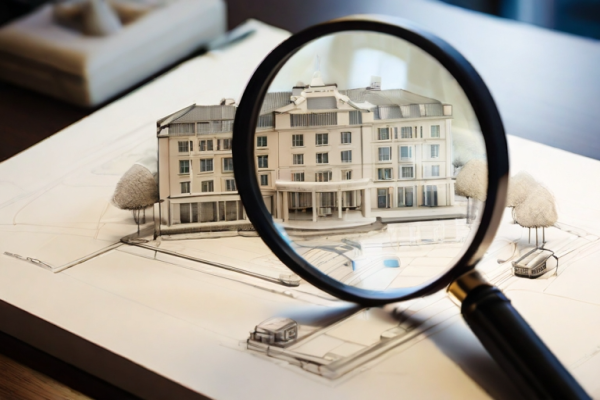Technical Due Diligence – TDD for short – has become a particularly popular service offered by 3E Group in recent years. Mr. Peter Bona, one of our Technical Directors describes this service, based on his expertise and more than 40 years of professional experience. He also added, that the technical due diligence assignments are often a journey through history, involving very interesting and technical assignments that require considerable comprehensive engineering knowledge and practical experience.
In what cases might this service be necessary/useful?
Purchasing a property is a major decision, often involving a multi-million euro deal. When making such a decision, the most important thing is to know what you are buying and what is the associated price, which is of course a negotiation process. In order to bargain well you need to know the most important information about the property. One of these is the condition of the property in relation to its age, and this is where 3E Group’s TDD service can be of paramount importance.
What is the difference between “LDD” and “TDD”?
The “LDD”, or legal due diligence, looks at issues such as whether there are encumbrances on the property or whether anyone, such as the state, has a right of first refusal that could affect the value of the property.
“TDD”, or Technical Due Diligence, is an abbreviation for “Technical Due Diligence”. Due diligence means ‘due depth’, ‘due care‘ – so due diligence should be like an X-ray, but more like a modern MR scan. We need to uncover any defects, risks, other technical circumstances that could affect the current and future value of the property.
Property changes, just like a human body, after a while it becomes obsolete and old. However, its condition is greatly affected by the quality and frequency of maintenance.
What are the areas covered by a technical due diligence and what risks are you looking at?
The Technical Due Diligence review covers different engineering disciplines such as architectural, structural, mechanical, electrical, low voltage, issues etc. – practically every part of the involved engineering shall be investigated. In the architectural part, we also look at whether the property can be extended, as this can add value in the future, for example if another storey can be added or if the regulations allow for additional building extension.
The range of potentially risky factors can be very wide. We have already had projects where the property was located on the site of a former Soviet barracks, so we had to check whether there was any radioactive contamination.
TDD can also look at the expected maintenance costs of a building. This can be particularly important nowadays, when energy prices are very high.
What documents do you work from?
A complete, digitised design documentation of the right quality is very important for due diligence. It’s like a service book before buying a used car, with all previous oil changes and car maintenance services neatly documented. It is always positive if the same company has done the maintenance on a property, because this can also be a risk factor. In the absence of planning documentation, we do not know the foundation of a property, for example, we do not know its load-bearing capacity, which is important if we want to build on it. We can effectively measure/survey a building with a laser scanner, but we cannot get all the essential information, as scanning cannot reveal the hidden parts.
We have had several projects where the owner commissioned us to search for the available documents of the the property before the sale, to locate design documentation. In such cases, we check what and where else is available, and therefore we may have to search for missing plans in archived document storages.
Typically, for what kind of projects is this service ordered and for what kind of clients?
No two projects are ever the same, and we even have studied buildings over a hundred years old. Sometimes the client wants to buy more property, or sometimes they want to buy a existing logistics hall and to convert it into a manufacturing plant. In such cases, we have to check whether the building and its existing utility network capacities are in principle suitable for a different function after conversion, whether there is enough capacity from an electrical point of view, whether there is enough potable or grey water, etc.

Our clients are typically investment or real estate development companies, foreign manufacturing companies looking to set up investments in Hungary. In such cases, as part of a greenfield investment, they carry out a development TDD, in which we look at the qualification of the land, whether the building regulation plan allows for the type of industrial development, whether the size of the land is sufficient, whether there is a suitable road connection, utility connection possibilities, etc. This is a land development study. Of course, the price of the service always depends on the depth and detail of the TDD that the client has prepared. It is important to know what you want and what the purpose of the project is.
We also have international projects, for example, a previous client wanted to analyse existing facilities in the former Yugoslavia, and our results indicated that it was not worthwhile to undertake such a scale of development there – these projects are also very important from the client’s point of view. Wise proverb: if you can’t forecast predictable profit, don’t plan for unpredictable expenditure.
What team within 3E Group do you use to perform this TDD service, and roughly how long does it take to do a due diligence?
In addition to 3E’s stable internal team, we have been able to provide our potential clients with expertise in all disciplines from our existing professional subcontracting partners. We have a well-developed internal due diligence system for these tasks, a risk assessment strategy, a factual reporting form with sufficient depth.
The lead time for a TDD depends on the complexity, how many site visits are required etc., Normally it usually takes 4-6 weeks to complete a draft report. The client usually has a week to review it and ask questions, followed by the issue of the final TDD report.
What can be the outcome of a due diligence?
The result of the technical due diligence is appropriate if we can tell our Client the level of wear and tear of the building. It also includes the description : how it has been maintained, what risks are to be expected from a technical point of view, e.g. water leaks, wetness, subsidence, necessary replacement of obsolete M&E equipment, etc., any factor that has a major impact on the value of the property.
There are cases where the owner only asks for a preliminary report, a so-called “red flag report”, which is abbreviated to “RFR”. In this, only the most important things are examined and the client receives a preliminary overview in the form of an excel spreadsheet for a lower fee. If a red flag report reveals a reason for exclusion, the project fails, a red flag is raised. With this in mind, there is no point in wasting further time and money on a detailed investigation.
It is important for the client to have the independent and factual information from the TDD to be able to argue and negotiate easily with the property owner in a bargaining process. As a result of a good TDD, our commission fee – initially just a cost to the client – can be converted into a discount from the selling side during the negotiation process, as both the seller and the buyer get an up-to-date, accurate picture of the property’s condition.
The purpose of a TDD is therefore to provide an independent, reliable, technically supported description of the condition of a marketable property.
Of course, the language of TDD needs to be made commonplace, as neither the seller nor the buyer is a technical experts.
Last but not least, of course, the best tasks are those ones that result in a successful acquisition project after our TDD.
In many cases, a successfully completed TDD can also generate additional work if we can be involved in the implementation of the development project as a technical inspector or project manager after the acquisition.



